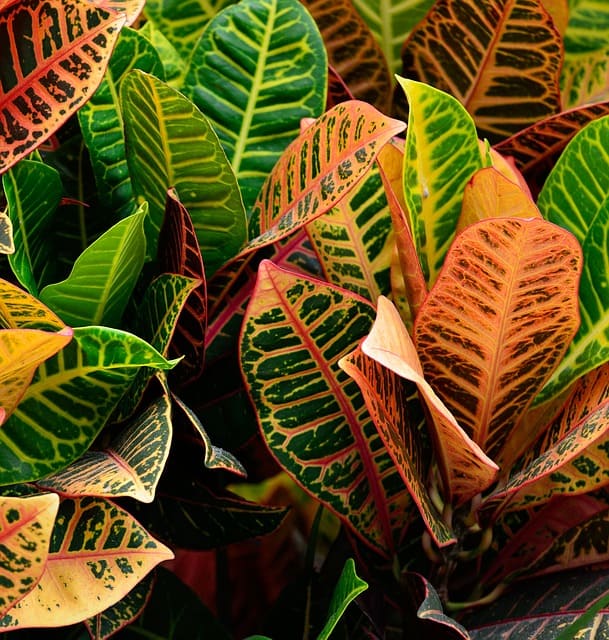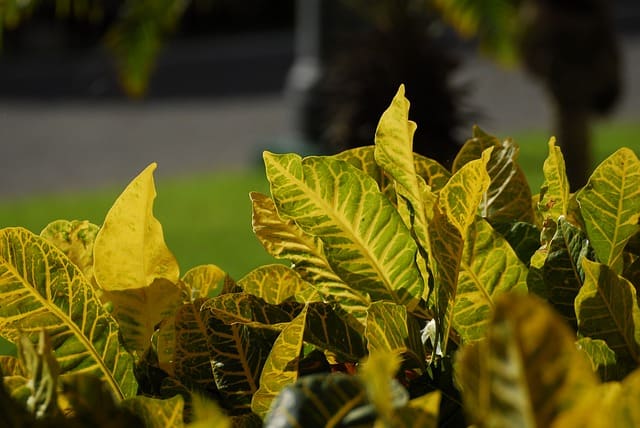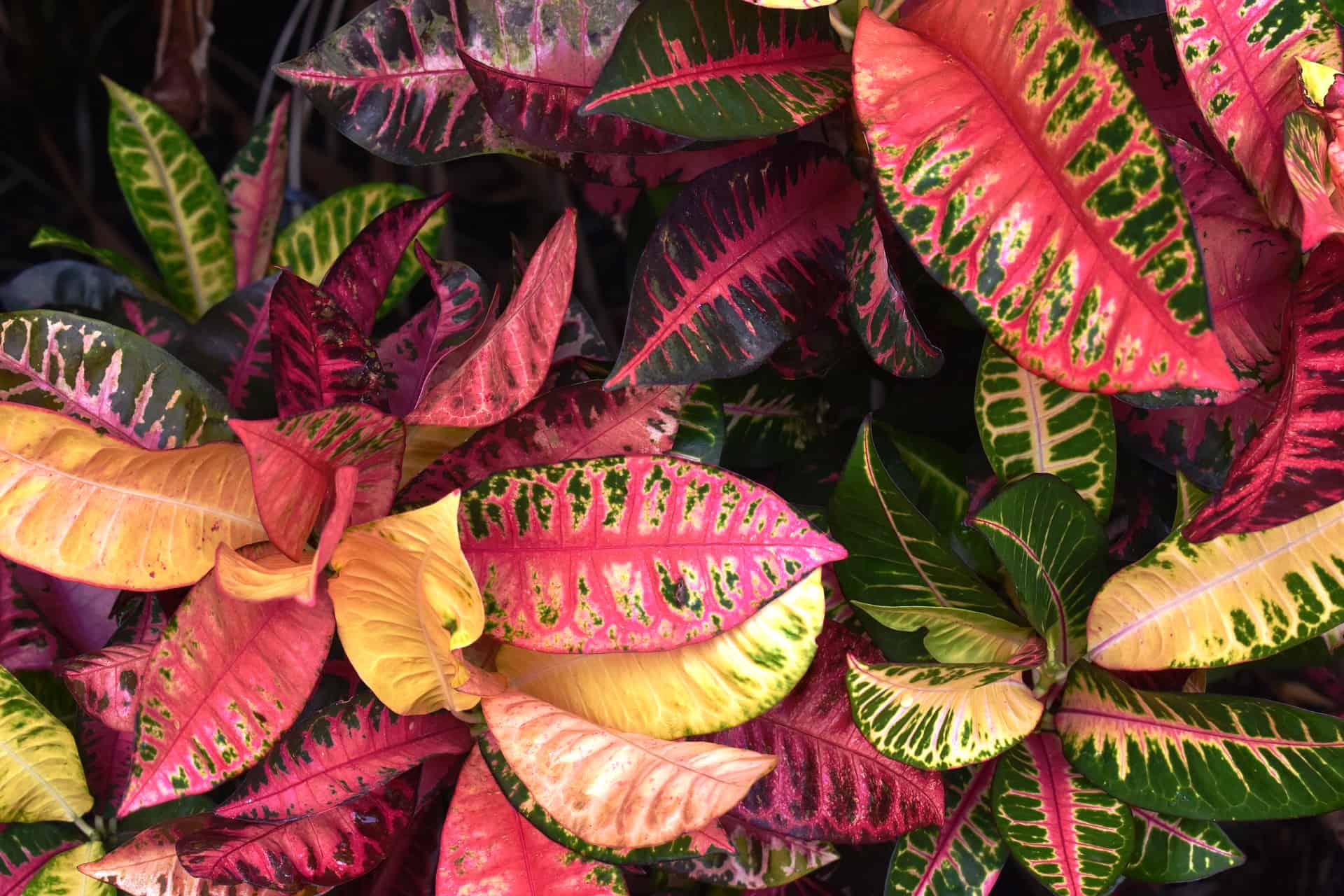Crotons are some of the most colorful plants that you can add to a tropical landscape. However, sometimes their color can fade and their leaves can start to look dull and tattered. When that happens it’s usually a sign of a nutrient deficiency that needs to be addressed as soon as possible. That’s why we compiled this guide on the best fertilizer for crotons that will help your plant flourish.
The University of Florida has found that a fertilizer with an 18-6-12 NPK ratio (Buy Online) leads to the healthiest and most colorful croton plants outdoors and in containers.
Best Fertilizer for Crotons
| Image | Name | Rating | Shop |
|---|---|---|---|
 | Osmocote Classic 18-6-12 NPK, 8-9 Month Time Release | ||
 | Myco Boost 18-6-12 Granular Fertilizer + Mycorrhizae | ||
 | Organic SuperGreen Kelp Foliar Spray | ||
 | Dr. Earth 756P Exotic Blend |
How to Fertilize Croton

Croton (Codiaeum variegatum), is a beautiful plant with colorful variegated leaves that make it stand out in any landscape. The croton plant is native to tropical regions of the world where it thrives in areas with plenty of rain and high humidity. Crotons don’t produce flowers, but their leaves create a brilliant display of green, purple, orange, yellow, and red colors.
To keep your croton plants healthy you’ll need to apply a balanced fertilizer to both croton plants in containers and croton plants outdoors to improve their overall growth and color.
Step 1
The best fertilizer for crotons is a low-nitrogen, time-released, granular fertilizer, that has an 18-3-6 NPK ratio. You should sprinkle the fertilizer around the base of the plant in early spring just as the weather starts to warm up.
If you have a potted croton plant you should apply a small amount of fertilizer around the base of the plant and gently mix the granules into the top layer of the soil.
For outdoor croton plants, you’ll want to apply the fertilizer around the drip line of the plant about 12 to 18 inches away from the crotons stem. You also might want to gently rake the time-released fertilizer into the top 1/4-inch of the soil to prevent it from floating away in a torrential downpour.
Step 2
After you apply the fertilizer you should thoroughly water the plants with at least 1-2-inches of water to start releasing some of the fertilizer into the soil.
Step 3
It’s also a good idea to apply more fertilizer to your crotons halfway through the growing season. Follow the same application process as in the previous steps, but be careful not to over-fertilize the plants since croton plants don’t need a lot of nutrients in the fall and winter.
READ MORE: Croton Plant Varieties – Types of Crotons
Best Fertilizer for Crotons
Dr. Earth INC 756P Exotic Blend
Dr. Earth Exotic Blend (Buy Online) contains all the nutrients that a tropical plant needs for optimal growth. This organic fertilizer has a 5-4-6 NPK ratio and it contains added probiotics and beneficial mycorrhizae spores. It also has some extra magnesium and sulfur that tropical plants need to thrive in depleted sandy soil.
Organic SuperGreen Kelp Foliar Spray for Plants by Bloom City, Quart (32 oz)
Organic SuperGreen Kelp Foliar Spray (Buy Online) is a great way to deliver a dose of organic nutrients to a croton plant’s leaves. This foliar fertilizer contains a mix of kelp, magnesium, fulvic acid, trace nutrients, and plant hormones that will improve yellow leaves much faster than soil based fertilizer.
Jobe’s Fertilizer Spikes
Jobe’s Fertilizer Spikes (Buy Online) are a quick and easy way to ensure your potted croton plants always have the right amount of fertilizer. These fertilizer spikes have a 10-10-4 NPK ratio and they last for up to 60 days before they need to be replaced.
Croton Soil
Miracle-Gro Indoor Potting Mix 72776430 6 Quart (2 Pack)
Miracle-Gro Indoor Potting Mix (Buy Online) is the best soil for crotons since it has been formulated specifically for tropical potted plants. This soil contains coconut coir, which retains moisture and drains better than regular potting soil, and it also contains Miracle-Gro fertilizer that will feed your croton plants for up to 6 months before you need to add more fertilizer.
Croton Problems
Why Are My Croton Leaves Turning Yellow

If your croton plant has leaves that star to fade or turn yellow it might have a nitrogen deficiency. Try adding a small amount of time-release fertilizer around the base of the plant and watch to see if the leaves return to their normal color.
Indoor croton plants can also turn yellow if they are exposed to excessive sunlight, and if you think that’s the problem move the plant to a less bright area away from the window.
Waterlogged croton plants may also start to show yellowing in their leaves, so it’s a good idea to avoid overwatering your plants and make sure you plant your croton in a pot with good drainage in tropical potting soil.
Why Are My Croton Plant Care Leaves Falling Off
The leaves of a croton plant will fall off for several reasons, First, your plant’s leaves might have fallen off if it was exposed to extremely hot or cold temperatures. Also, low humidity can cause a croton plant to shed its leaves in an attempt to conserve moisture.
Indoor croton plants will drop their leaves if they don’t get enough light, or if they are suffering from a nutrient deficiency. If you’ve already ruled out temperature and humidity then a lack of nutrients might be at the root of the problem.
Why Are My Croton Leaves Curling
A croton plant leaves will usually start to curl due to a lack of water or humidity. If they are very soft to the touch and they don’t have any rigidity it’s probably due to under-watering. Otherwise, if the leaves still have some rigidity then it might be due to low humidity.
If your house gets dry in the winter or if you live in a dry climate you might want to consider getting a humidifier. A cool-mist humidifier will help keep your croton plants leaves healthy, or you can hand mist your plants daily, but a humidifier is usually a more stable source of humidity.
If the leaves of your croton start to turn brown and they feel dry and crisp to the touch, then the most likely problem is a lack of water. However, in some cases, if you see small white or brown spots with yellow margins, then your plant might be infected with Leaf Spot Disease.
Croton Fertilization Guide

Croton plants need a balanced fertilizer to reach their full growth potential. However, they aren’t a very “hungry” plant so they don’t need an excessive amount of fertilizer.
The fertilizer you use on crotons should contain a good balance of nitrogen and potassium, but feeding a croton plant too much nitrogen can cause the leaves to become dull, and you might burn the plant’s roots if you over-fertilize.
When croton plants are dormant in the winter you can limit or cease fertilization altogether since the plant’s growth will slow down in the cooler weather.
How Many Ounces of Fertilizer to Add a Croton in a Container.
18-6-12 NPK Ratio
3 ounces per 10-inch pot.
3-1-2 NPK Ratio
1 ounce per 10-inch pot.
Crotons that are grown the ground will need less fertilizer than plants grown in pots or containers.
Crotons need a soil pH that falls in a range of 4.5 to 6.5. You can increase the soil pH with dolomite lime or you can lower the pH with sulfur.
Fertilizers that have an NPK ratio near 3-1-2 or 18-6-12 produce the best results, and crotons respond well to both liquid or slow-release fertilizers.
Plants grown in pots or containers need 1,500-2,000 pounds of nitrogen per acre each year from a fertilizer that has a 3-1-2 NPK ratio. While plants grown in the ground will only need 900 pounds of nitrogen per acre each year to reach their full growth potential.
Excessive fertilization will reduce the color and intensity of croton leaves, and it can even harm the root system and dwarf the plant which can cause it to perish in a worst-case scenario.
Sources:
University of Florida Extension – “Croton Production and Use”









